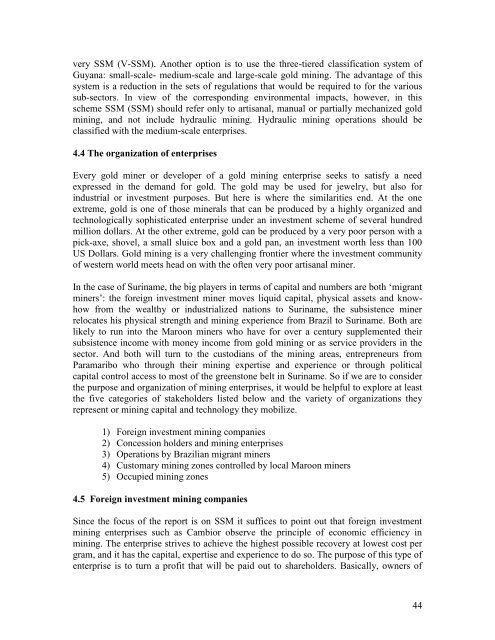SITUATION ANALYSIS OF THE SMALL-SCALE GOLD ... - WWF
SITUATION ANALYSIS OF THE SMALL-SCALE GOLD ... - WWF
SITUATION ANALYSIS OF THE SMALL-SCALE GOLD ... - WWF
You also want an ePaper? Increase the reach of your titles
YUMPU automatically turns print PDFs into web optimized ePapers that Google loves.
very SSM (V-SSM). Another option is to use the three-tiered classification system of<br />
Guyana: small-scale- medium-scale and large-scale gold mining. The advantage of this<br />
system is a reduction in the sets of regulations that would be required to for the various<br />
sub-sectors. In view of the corresponding environmental impacts, however, in this<br />
scheme SSM (SSM) should refer only to artisanal, manual or partially mechanized gold<br />
mining, and not include hydraulic mining. Hydraulic mining operations should be<br />
classified with the medium-scale enterprises.<br />
4.4 The organization of enterprises<br />
Every gold miner or developer of a gold mining enterprise seeks to satisfy a need<br />
expressed in the demand for gold. The gold may be used for jewelry, but also for<br />
industrial or investment purposes. But here is where the similarities end. At the one<br />
extreme, gold is one of those minerals that can be produced by a highly organized and<br />
technologically sophisticated enterprise under an investment scheme of several hundred<br />
million dollars. At the other extreme, gold can be produced by a very poor person with a<br />
pick-axe, shovel, a small sluice box and a gold pan, an investment worth less than 100<br />
US Dollars. Gold mining is a very challenging frontier where the investment community<br />
of western world meets head on with the often very poor artisanal miner.<br />
In the case of Suriname, the big players in terms of capital and numbers are both „migrant<br />
miners‟: the foreign investment miner moves liquid capital, physical assets and knowhow<br />
from the wealthy or industrialized nations to Suriname, the subsistence miner<br />
relocates his physical strength and mining experience from Brazil to Suriname. Both are<br />
likely to run into the Maroon miners who have for over a century supplemented their<br />
subsistence income with money income from gold mining or as service providers in the<br />
sector. And both will turn to the custodians of the mining areas, entrepreneurs from<br />
Paramaribo who through their mining expertise and experience or through political<br />
capital control access to most of the greenstone belt in Suriname. So if we are to consider<br />
the purpose and organization of mining enterprises, it would be helpful to explore at least<br />
the five categories of stakeholders listed below and the variety of organizations they<br />
represent or mining capital and technology they mobilize.<br />
1) Foreign investment mining companies<br />
2) Concession holders and mining enterprises<br />
3) Operations by Brazilian migrant miners<br />
4) Customary mining zones controlled by local Maroon miners<br />
5) Occupied mining zones<br />
4.5 Foreign investment mining companies<br />
Since the focus of the report is on SSM it suffices to point out that foreign investment<br />
mining enterprises such as Cambior observe the principle of economic efficiency in<br />
mining. The enterprise strives to achieve the highest possible recovery at lowest cost per<br />
gram, and it has the capital, expertise and experience to do so. The purpose of this type of<br />
enterprise is to turn a profit that will be paid out to shareholders. Basically, owners of<br />
44
















